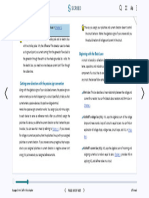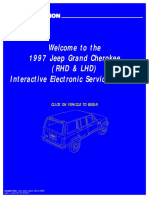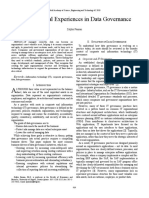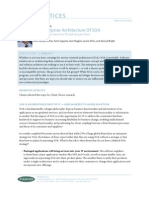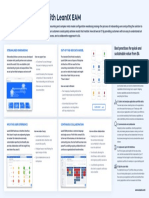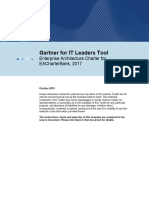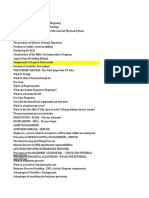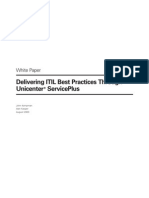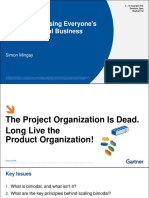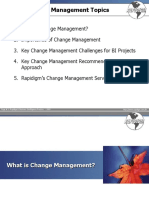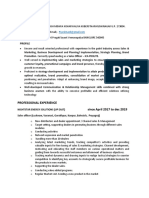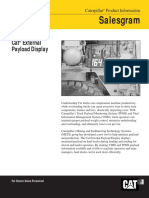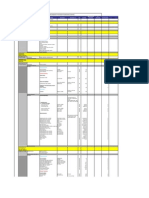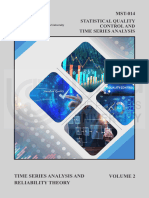Aligningby Process Acrossa Large Enterprise
Aligningby Process Acrossa Large Enterprise
Uploaded by
sudhirpatil6Copyright:
Available Formats
Aligningby Process Acrossa Large Enterprise
Aligningby Process Acrossa Large Enterprise
Uploaded by
sudhirpatil6Original Description:
Original Title
Copyright
Available Formats
Share this document
Did you find this document useful?
Is this content inappropriate?
Copyright:
Available Formats
Aligningby Process Acrossa Large Enterprise
Aligningby Process Acrossa Large Enterprise
Uploaded by
sudhirpatil6Copyright:
Available Formats
AligningbyProcessAcrossaLargeEnterprise
HowoneworldwideorganizationhascustomizedAPQC'sProcess
ClassificationFrameworktoenhanceperformanceandinformation
sharing
ByMichelleCowan
OneofAPQC'smembers,alargeenergy(petroleum,oil,gas,chemicals)organizationwithassetsof$150
billionandoperationsinmorethan30countries,isaligningitsworkaccordingtoprocessesoutlinedin
APQC's Process Classification Framework (PCF). Each department within the organization is taking the
PCF and tweaking it to match the processes particular to its business. The enterprise has achieved
tremendous success with this in IT, and the methods employed there are being replicated in the other
areas.
STARTINGTOALIGNBYPROCESS
Trying to standardize processes across a worldwide enterprise can be daunting. With upstream
petroleumoperationsacrossthelower48states,Alaska,Norway,andothercountries,theorganization
struggledtoalignprocessessothatimprovementscouldbemadeacrosstheboard.
Theorganizationneededawaytostoreknowledgeandinformationaboutallofitssitesandactivitiesso
thattheinformationcouldbeleveragedbyoutpostsaroundtheglobe.Thebestsolutionseemedtobe
toimplementcontentmanagementsystemsandothertechnologiesbasedonacommonframeworkof
processes. The organization finally settled on APQC's Process Classification Framework (PCF) as the
backboneofitsprocessinventory.
APQCs PCF had the highestlevel, most comprehensive structure they could find. It offered enough
structure to set a standard and then familiarize people in each part of the business with process
thinking,butitwasopenenoughtoallowforcustomizationwherenecessary.
MAKINGTHECASEFORPROCESSALIGNMENT
Itwaseasiertoimplementaprocessframeworkwithinthedownstreampetroleumpartofthebusiness
thanintheupstreamsegments.Upstreamprocessesdealwithalltheactivitiesnecessarytopumpand
acquiretheoil.Downstreamprocessesincludetherefinementanddeliveryoftheproducttocustomers.
Downstream employees more readily saw their work as congruous to that of other downstream
functions,butupstreamemployeesbelievedtheworkperformedattheirindividualsiteswasrelatively
unique and did not immediately understand the need to link their work in a process chain to other
functionsinthebusiness.
Foradditionalinformation,emailapqcinfo@apqc.org.
2010APQC.ALLRIGHTSRESERVED. K01494 Page1
Foradditionalinformation,emailapqcinfo@apqc.org.
2010APQC.ALLRIGHTSRESERVED. K01494 Page2
Despite early hesitation, what appealed to managers at upstream sites was the potential to share best
practicesacrossthediversesitelocations.Eventhoughtheycouldnotenvisionalltheirworkprocesses
lining up according to a framework at first, they are becoming increasingly willing to see how a
framework could be used to standardize the way information is documented, organized, and shared
amongdifferentsitesandbusinessunits.
Toincreasebuyin,leadershiphashadtoeducateemployeesonwhat"process"meansandthebenefits
that can result from content and performance management based on process (e.g., learning from a
variety of sites, standardization, increased efficiency, enhanced communication). The topdown nature
oftheprocessedictalsohelpedmovechangeforward.
ASSIGNINGPROCESSOWNERSHIPANDACCOUNTABILITY
Each organization within the enterprise (e.g., IT, HR, finance, all international organizations) is tasked
with customizing the PCF to match their processes. APQC's PCF provides a consistent backbone and
startingplaceforeachgroup,buteachbusinesshasfreereigntoensurethattheirframeworkaccurately
reflectstheworkbeingdone.
Thevariousbusinessesarecreatingtheseindividualprocesshierarchiesandmakingsuggestionsforthe
enterprise framework, but leaders will review the recommendations and preliminary process
frameworks to create standardized versions that can span the entire enterprise. Each group has a
framework it is already using, so adopting a consistent standard is fairly challenging. Some businesses
have embraced process thinking and understand the need to align the enterprise according to a single
standard, but leadership still faces some obstacles to getting complete buyin across all divisions or
areas.
ALIGNINGPROCESSESWITHINTHEITFUNCTION
IThadaparticularinterestinmovingtowardprocessthinkingbecauseitneededtofindawaytosupply
and maintain technological systems in every location as costeffectively and with as little conflict as
possible.Tostreamlineitsprocesses,ITdevelopedan"ITProcessInventory"specifictotheorganization,
which combines APQC's PCF, COBIT
1
, and ITIL
2
. This has proved extremely effective, and all of their
processesaligntoit.ITcanshareandlookupinformationbasedonthenumbersoftheprocessesrather
thantryingtosearchaccordingtootherfactors(e.g.,location,equipment,systems).Itismucheasierto
findsolutionsthathaveworkedbeforeaspeople begintofilenewrecords (andretroactivelyfileolder
records)accordingtotheprocessframework.
1
ControlObjectivesforInformationandrelatedTechnology(COBIT)isawidelyusedframeworkforITmanagementcreatedby
theInformationSystemsAuditandControlAssociation(ISACA)andtheITGovernanceInstitute(ITGI).
2
TheInformationTechnologyInfrastructureLibrary(ITIL)isacollectionofbestpracticeapproachesandmodelsforIT,a
registeredtrademarkoftheOfficeofGovernmentCommerceintheUnitedKingdomandothercountries.
ThecurrentlistofleveloneprocesseswithinIT'scustomizedprocesscategory7.0Manageinformation
technologyis:
7.1ManagetheITportfolio
7.2DevelopandmanageITcustomerrelationships
7.3ManageITpoliciesandstandards
7.4Manageenterprisecontentandinformation
7.5ManageITinfrastructureandapplications
7.6ManageITservicesandsupport
7.7ManageITrequests
7.8ManageITpeople
7.9ManageITknowledge
LESSONSLEARNEDANDCURRENTENTERPRISECHALLENGES
Leadership support has been critical for process framework implementation. The designation of a
special team, the Process Executive Council, in IT ensured that adequate resources were allocated for
the effort of aligning the framework. Because alignment was a corporate priority, employees were
granted the time needed to devote energy to the task of customizing a framework. This model of
implementationisbeingreplicatedinotherbusinessunitsbecauseitdidprovesoeffectiveinIT.
Theorganizationisstilldeterminingitsmeasurementstrategy.Itcitesthisasoneofthekeymissing(or
underdeveloped) pieces of its current performance improvement and alignment approach. It wants to
develop measures at each process level to track progress toward performance objectives. Right now,
the organization tracks a dashboard of metrics and indicators, but none of these are aligned with the
framework or coalesce in true "balanced scorecard" fashion. Some of the measures tracked in IT, for
example,include:
Budgetperformance
Totaloperatingbudget
Safety(e.g.,accidents,nearmisses,ergonomictrainingassessments)
Compliance
Security(e.g.,numberofvulnerabilitiespatched,numberofsecuredmachines)
Operatingefficiency
IThelpdeskresolutionrate
CalltimetoreachITsupportperson
Callanswerrate
Outages
Plannedoutages
Lostprofitopportunity(i.e.,howmanydollarswouldbelostifXequipmentwentdown)
Foradditionalinformation,emailapqcinfo@apqc.org.
2010APQC.ALLRIGHTSRESERVED. K01494 Page3
Theenterprisehasbeensuccessfulingeneratingchangeinmostofitsbusinessunits,despitereluctance
orhesitancyinsomeareas.Afewofthethingsithaslearnedduringtheprocessinclude:
Getting a consistent group together to engineer the process alignment is key. When managers
change, everything changes, and new people have to be trained. This is a challenging and time
consumingordeal.
Bring frameworks to at least 80 percent complete alignment with actual work. If an 80 percent
agreementcanbereachedamongthoseworkingontheproject,thentheframeworkwilllikelypass
executivescrutinyandbeusedeffectivelyinmanypartsofthebusiness.
Do not wait too long to begin changing. The organization was stalled by spending too much time
putting process owners in place. Many process owners would shift positions, move locations, or
leave the organization before real alignment or mapping efforts began. In the end, the changes
simply needed to be initiated, with the appropriate individuals identified and trained for various
rolesalongtheway.
Therolesandplansdonothavetobeperfectforimplementationtobegin.Spendingtoomuchtime
engineeringframeworksanddeterminingwhowillchampionprocessalignmentineachbusinesscan
stopprogressfrombeingmade.Ideashavetobetestedunderrealconditions,andcommunication
with the work force cannot be delayed. Starting at 80 percent readiness ensures that employees
have the opportunity to provide input and that roles and responsibilities can change as efforts
evolvetoward100percentcompletion.
CONCLUSION
This organization feels that shifting to a process alignment is definitely the right move. The IT function
hasseenbenefitsin costs andefficiencyfromensuringthatrecordsandservicesaretrackedaccording
toprocesses.Otherpartsofthebusiness,particularlysupplychainandfinance,alsolendthemselvesto
aprocessstructure.Theyaresuccessfullymovingtowardtotalalignment,whichisresultinginimproved
performanceandbolsteringthecaseforenterprisewideadoptionofprocesshierarchies.
Implementing a process standard in the upstream petroleum business is still a challenge, but at this
point, change management efforts have at least sparked the upstream businesss interest in sharing
informationandlearningfromthebestintheenterprise.Topdownleadershipisensuringthateachpart
oftheorganizationisalignedandlearninghowtouseaprocessstructure.
As a result of improvements already evident in some business areas, the organization sees potential
performanceimprovementsacrosstheboardasaresultofcustomizedprocessalignment.Muchofthe
work force also recognizes this possibility. The difficulty now is keeping consistent teams in place to
facilitate the alignment of sitespecific processes and the development of an overarching structure for
upstream operations that can be used and accepted worldwide. Based on success in downstream and
othersupportingbusinesses,leadersbelieveprocessalignmentiswellworththeeffort.
Foradditionalinformation,emailapqcinfo@apqc.org.
2010APQC.ALLRIGHTSRESERVED. K01494 Page4
Foradditionalinformation,emailapqcinfo@apqc.org.
2010APQC.ALLRIGHTSRESERVED. K01494 Page5
ABOUTAPQC
For more than 30 years, APQC has been on the leading edge of improving performance and fostering
innovationaroundtheworld.APQCworkswithorganizationsacrossallindustriestofindpractical,cost
effective solutions to drive productivity and quality improvement. We are a memberbased nonprofit
currentlyservingmorethan500organizationsinallsectorsofbusiness,education,andgovernment.
CONTACTINFORMATION
123NorthPostOakLane,ThirdFloor
Houston,TX770247797
phone:+17136814020or8007769676
fax:+17136818578
email:apqcinfo@apqc.org
www.apqc.org
You might also like
- Circuit Analysis For DummiesDocument1 pageCircuit Analysis For Dummiesserviceseasy3No ratings yet
- 33507279117Document3 pages33507279117Ramy RabicoNo ratings yet
- 1997 Jeep Grand Cherokee Electronic Service Manual PDFDocument2,262 pages1997 Jeep Grand Cherokee Electronic Service Manual PDFJuan José Montano Quintanilla100% (7)
- TD Bank - IBM Case StudyDocument8 pagesTD Bank - IBM Case StudyArik RizerNo ratings yet
- Grade 12 - General Biology 2 Q1W1Document22 pagesGrade 12 - General Biology 2 Q1W1Vincent Joshua De100% (3)
- Nift Case Study Sheet 2Document1 pageNift Case Study Sheet 2tanu kukreja0% (1)
- OCEB-2-Fundamental Exam InstructionDocument3 pagesOCEB-2-Fundamental Exam InstructionPraddy BrookNo ratings yet
- KSA Portfolio GuidelinesDocument40 pagesKSA Portfolio GuidelinesGalina DonevskaNo ratings yet
- CHAOS Report JohnsonMulder Horend Bij Presentatie Hans MulderDocument19 pagesCHAOS Report JohnsonMulder Horend Bij Presentatie Hans MulderM. Vefa ArıkanNo ratings yet
- Some Practical Experiences in Data Governance: Zeljko PanianDocument8 pagesSome Practical Experiences in Data Governance: Zeljko PaniantextbackgroundNo ratings yet
- Ascent SW User Manual For Fluoroskan Ascent, CF & FLDocument400 pagesAscent SW User Manual For Fluoroskan Ascent, CF & FLFernando Oviedo100% (1)
- ITMGD Sample Report PDFDocument53 pagesITMGD Sample Report PDFMMADMINNo ratings yet
- Effective Governance During SOA Lifecycle - Theory and PracticeDocument15 pagesEffective Governance During SOA Lifecycle - Theory and PracticepreethiscribdNo ratings yet
- Session 4Document65 pagesSession 4ghazi almhmmadi100% (1)
- CMMI AcceleratedDocument108 pagesCMMI Acceleratednmukherjee20No ratings yet
- 1 Intro To Enterprise ArchitectureDocument76 pages1 Intro To Enterprise ArchitecturechachamohsinNo ratings yet
- E TOMsDocument178 pagesE TOMsMAGISTERSCNo ratings yet
- MSF For Cmmi Process Improvement v5 Process GuidanceDocument68 pagesMSF For Cmmi Process Improvement v5 Process GuidancesemiariNo ratings yet
- Capability Maturity Model Integration: April 2017Document11 pagesCapability Maturity Model Integration: April 2017Eu Meu MesmoNo ratings yet
- Mejora ContinuaDocument14 pagesMejora ContinuaCharly PerezNo ratings yet
- Application Rationalization - Torry Harris WhitepaperDocument7 pagesApplication Rationalization - Torry Harris WhitepaperTorry Harris Business SolutionsNo ratings yet
- Cobit Audit Questionnaire: P01 Define A Strategic IT Plan: Confidential When Filled inDocument5 pagesCobit Audit Questionnaire: P01 Define A Strategic IT Plan: Confidential When Filled inNielz TulalessyNo ratings yet
- Top Priorities For It: Leadership Vision For 2021: Cios and Heads of ItDocument8 pagesTop Priorities For It: Leadership Vision For 2021: Cios and Heads of ItThe Zensitive GroupNo ratings yet
- Can Enterprise Architecture Save The DinosaursDocument39 pagesCan Enterprise Architecture Save The DinosaursKinkinNo ratings yet
- Balance ScorecardDocument12 pagesBalance ScorecardAlejandro LSNo ratings yet
- Designing A Business Process Architecture 2Document11 pagesDesigning A Business Process Architecture 2codru_greenNo ratings yet
- Oracle Digital Transformation of Product Design Report FinalDocument20 pagesOracle Digital Transformation of Product Design Report Finalyken43100% (1)
- SOA-Forrester SOA Enterprise Architecture Best PracticesDocument7 pagesSOA-Forrester SOA Enterprise Architecture Best PracticesKalpan Raval100% (1)
- Corporate Strategic Information Systems PlanningDocument28 pagesCorporate Strategic Information Systems PlanningFakhrulrazi Ibrahim0% (1)
- Glossary of Business TermsDocument20 pagesGlossary of Business TermsEmilee Rachael NicolaiNo ratings yet
- LeanIX Poster Faster Time To Value With LeanIX EAM enDocument1 pageLeanIX Poster Faster Time To Value With LeanIX EAM enEduardo ManchegoNo ratings yet
- Business Process EtomDocument78 pagesBusiness Process EtomRaul Angel VELARDE SAPAICO100% (1)
- Sloan Management Review Mark Jeffery and Ingmar LeliveldDocument13 pagesSloan Management Review Mark Jeffery and Ingmar Leliveldnikhilsharma5No ratings yet
- Example Ea CharterDocument7 pagesExample Ea CharterktinoooooNo ratings yet
- FLR005 TOGAF AcceleratorDocument2 pagesFLR005 TOGAF Acceleratorprince2venkatNo ratings yet
- The Future of Business Reimagining 2020 and Beyond PDFDocument9 pagesThe Future of Business Reimagining 2020 and Beyond PDFANUSHKA GOYALNo ratings yet
- Topic: Business Process Management (BPM) Management & StrategyDocument6 pagesTopic: Business Process Management (BPM) Management & StrategyTesfayé HailuNo ratings yet
- Exam QuestionsDocument13 pagesExam Questionsgauravgd16No ratings yet
- Towards A Digital Professional Body of KnowledgeDocument42 pagesTowards A Digital Professional Body of KnowledgeJaleel Ahmed Gulammohiddin100% (1)
- (2015) APQC - Connecting People To Content ReportDocument15 pages(2015) APQC - Connecting People To Content ReportMark Jimenez CervantesNo ratings yet
- A Comparison of The Top Four Enterprise-Architecture MethodologiesDocument31 pagesA Comparison of The Top Four Enterprise-Architecture Methodologiestinku9999No ratings yet
- Apm in The Togaf EnvironmentDocument3 pagesApm in The Togaf Environmentvenkat2002No ratings yet
- Demystifying Myths About The Automation Operating ModelDocument8 pagesDemystifying Myths About The Automation Operating ModelKNo ratings yet
- BPMN Pro PosterDocument2 pagesBPMN Pro PosterFrancisNo ratings yet
- A Survey of Information Technology GoverDocument27 pagesA Survey of Information Technology GoverLeo CerenoNo ratings yet
- ERP Pre Implementation Readiness AssessmDocument12 pagesERP Pre Implementation Readiness AssessmEdnan HanNo ratings yet
- NATO Security Investment ProgrammeDocument6 pagesNATO Security Investment ProgrammeFlorică Ghiță-GhenceaNo ratings yet
- Exhibit 3 - New York State Ies Target Operating ModelDocument63 pagesExhibit 3 - New York State Ies Target Operating ModelRavinder KNo ratings yet
- Delivering Itil Best PracticesDocument11 pagesDelivering Itil Best PracticesDavid Carter100% (1)
- The Edge Completes The Cloud: A Gartner Trend Insight ReportDocument26 pagesThe Edge Completes The Cloud: A Gartner Trend Insight Reportjuanito bananasNo ratings yet
- Bimodal - Raising Everyone's Game For Digital BusinessDocument32 pagesBimodal - Raising Everyone's Game For Digital BusinessMiguel SanchezNo ratings yet
- A Collaboration Framework For Cross-Enterprise Business Process ManagementDocument12 pagesA Collaboration Framework For Cross-Enterprise Business Process ManagementkokojerryNo ratings yet
- Ficoblazeadvisordecisionruleshowitworks4202wp 160302225024Document40 pagesFicoblazeadvisordecisionruleshowitworks4202wp 160302225024RajNo ratings yet
- DATAVERSITY Erwin State of Data Governance 2020 Final 012420Document16 pagesDATAVERSITY Erwin State of Data Governance 2020 Final 012420Jorge GarzaNo ratings yet
- BA Assessment and TrainingDocument9 pagesBA Assessment and TrainingemraheNo ratings yet
- Bi Ocm TRN Overview TemplateDocument34 pagesBi Ocm TRN Overview TemplateDafydd Silcock100% (1)
- B2 MMLDocument10 pagesB2 MMLvpascarielloNo ratings yet
- HP - Strong Buy: HP Lowers The BarDocument5 pagesHP - Strong Buy: HP Lowers The BarChetan AgarwalNo ratings yet
- TOGAF 9 Template - Data Dissemination DiagramDocument4 pagesTOGAF 9 Template - Data Dissemination DiagramBill ThomasNo ratings yet
- Information And Technology Strategy A Complete Guide - 2019 EditionFrom EverandInformation And Technology Strategy A Complete Guide - 2019 EditionNo ratings yet
- Enterprise Architecture EA A Complete Guide - 2019 EditionFrom EverandEnterprise Architecture EA A Complete Guide - 2019 EditionNo ratings yet
- Enterprise Content Management System A Complete Guide - 2020 EditionFrom EverandEnterprise Content Management System A Complete Guide - 2020 EditionNo ratings yet
- June 2024 Dentists (Written Phase)Document7 pagesJune 2024 Dentists (Written Phase)PRC BaguioNo ratings yet
- Crosby - G-291 Forged Nut Eye Bolts SpecsDocument3 pagesCrosby - G-291 Forged Nut Eye Bolts SpecsDaniel OrellanaNo ratings yet
- Dewatering For Tunnels and ShaftsDocument14 pagesDewatering For Tunnels and ShaftsDEBASIS BARMANNo ratings yet
- FIZ102E SuggestedProblemsDocument26 pagesFIZ102E SuggestedProblemsSelin PınarNo ratings yet
- Piping Study DrumsDocument31 pagesPiping Study Drumsradin202033% (3)
- Grey Knight Character SheetDocument2 pagesGrey Knight Character SheetMichael HassallNo ratings yet
- Piyush MishraDocument2 pagesPiyush MishraTimothy Bara (Abhay)No ratings yet
- Owner Manual Deh-S1053ub Deh-S1052ub Deh-S1050ub Gs Asia Middle EastDocument65 pagesOwner Manual Deh-S1053ub Deh-S1052ub Deh-S1050ub Gs Asia Middle Eastcristhian villabonaNo ratings yet
- Year 4 Science Program Overview - MaterialsDocument1 pageYear 4 Science Program Overview - Materialsameliabaker13No ratings yet
- Eigen Value Eigen Vector and DiagonalizationDocument19 pagesEigen Value Eigen Vector and Diagonalizationvolatility75sNo ratings yet
- Conny Tech Pte LTD: Progress Claims: No.1 LOA Ref: SCCCI/LOI/CH/012 Dated 7 September 2020Document1 pageConny Tech Pte LTD: Progress Claims: No.1 LOA Ref: SCCCI/LOI/CH/012 Dated 7 September 2020Zawhtet WinNo ratings yet
- Display CAT PDFDocument2 pagesDisplay CAT PDFAndres130No ratings yet
- Boq (110912)Document144 pagesBoq (110912)Ali AlaliNo ratings yet
- Hydraulic CalculationDocument7 pagesHydraulic Calculationsanjay vermaNo ratings yet
- Block 3Document148 pagesBlock 3Pramendra Kumar SinghNo ratings yet
- Interior Visualization and Postprocessing-2Document11 pagesInterior Visualization and Postprocessing-2MOHAMAD BASSEL SUMMAKIEHNo ratings yet
- REM.S - para Valvula Hidraulica ProporcionalDocument2 pagesREM.S - para Valvula Hidraulica ProporcionalvamelelectronicaNo ratings yet
- Summary of Findings, Conclusions, and RecommendationsDocument2 pagesSummary of Findings, Conclusions, and RecommendationsRaphael Gabriel Fernando100% (1)
- Class 6 - The Little Prince - 2022-23Document3 pagesClass 6 - The Little Prince - 2022-23SafaNo ratings yet
- On The Selection of Samples in Probability Proportional To Size Sampling: Cumulative Relative Frequency MethodDocument7 pagesOn The Selection of Samples in Probability Proportional To Size Sampling: Cumulative Relative Frequency MethodMd Moyazzem Hossain SabujNo ratings yet
- Physics: Class 10th (KPK)Document21 pagesPhysics: Class 10th (KPK)Muhammad naveedNo ratings yet
- Pierlite-C350 Gen2 Lowbay C350slse4Document2 pagesPierlite-C350 Gen2 Lowbay C350slse4anamarieNo ratings yet
- PMS Aircon ChecklistDocument1 pagePMS Aircon ChecklistVALERIE Y. DIZONNo ratings yet
